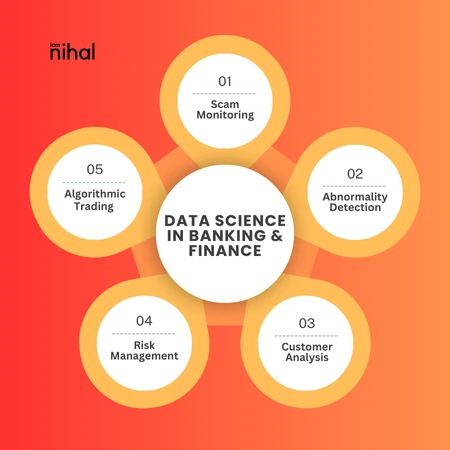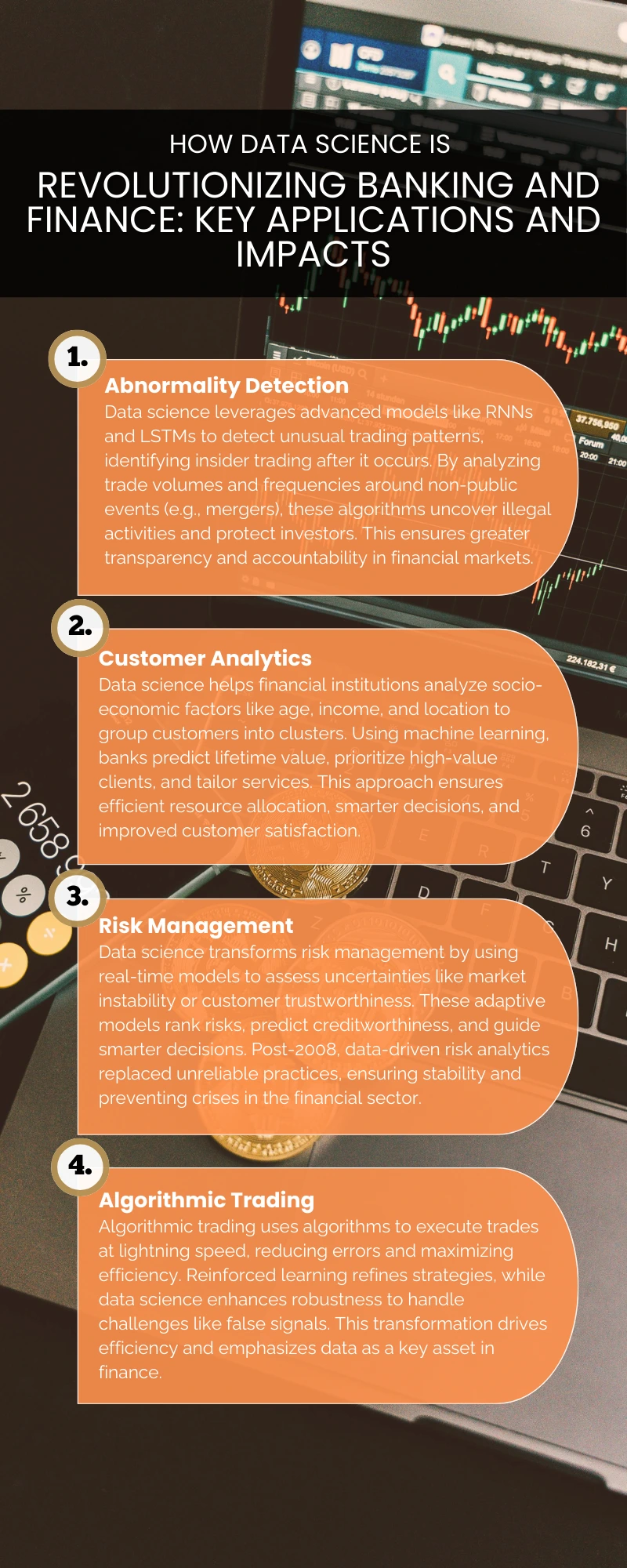Data Science for Banking: How Data Science Transforms the Finance and Banking Sector in Kerala
Banking has made some amazing progress from traditional techniques like involving checks or visiting branches for deposits and withdrawals. With the quick ascent of advanced banking, handling records and exchanges has become quicker, more intelligent, and more helpful. Banks all over the world have embraced web-based administrations to all the more likely serve their clients, however this digital shift has likewise prompted an enormous expansion in information. Here’s where Data Science for Banking becomes essential, helping financial institutions efficiently manage, track, and analyze this vast influx of information.
For decades, financial analysts have relied on data to extract valuable insights, but the rise of Data Science and Machine Learning (ML) has guided the banking sector into a new era in. Today, automated algorithms and high level analytical instruments cooperate to keep banks on the roll. Machine Learning (ML) and Deep Learning (DL), two critical parts of data science, utilize modern models to distinguish patterns, reveal bits of knowledge, and make future estimations. These advancing calculations permit banks to adjust and work on their system over the long run, making banking sharp, more productive, and more free.
Let’s look at how Data Science for Banking has transformed the banking and finance industry.
Corrupt practices like identifying theft and credit card scams remain significant challenges for the banking sector. Instances such as unusually high transactions from conservative spenders or out-of-region purchases often raise red flags for credit card fraud. When these patterns are detected, the affected cards are typically blocked immediately, and notifications are sent to the owners. This progressive approach helps banks protect their customers, themselves, and even insurance companies from substantial financial losses. While it might be slightly inconvenient to request a replacement card or make a phone call, the benefits far outweigh the downsides.
This is where Data Science for Banking plays a vital role. Techniques like random forests and machine learning algorithms analyze patterns to identify suspicious activities accurately. Additionally, advanced security features like facial recognition, fingerprint authentication, 3D passwords, text message confirmations, and PIN codes have significantly enhanced the safety of online transactions. However, it’s the initial fraud detection processes powered by data science that truly stand out. By recognizing patterns and irregularities, data science has revolutionized fraud prevention, offering unparalleled protection in today’s digital banking era.

Abnormality Detection
Unlike fraud avoidance, which focuses on stopping issues before they occur, abnormality detection aims to identify problems after they happen. This is because certain events can only be classified as “abnormal” in post analysis. In the financial sector, one key application of abnormality detection is identifying illegal insider trading.
In today’s highly-progressive financial markets, spotting unusual trading patterns with the naked eye is nearly impossible. While it’s normal for a trader to periodically make exact predictions about the rise or fall of a stock, there are ways of distinguishing when trading behavior falls outside normal patterns. This is where Data Science for Banking moves toward, utilizing advanced procedures like Recurrent Neural Networks (RNNs) and Long Short-Term Memory (LSTM) models to foster strong abnormality detection algorithms.
These algorithms analyze trading activities before and after significant non-public announcements, such as the launch of a new product or a company merger. By examining the volume and frequency of trades, data science models can detect when someone might be using confidential information to gain an unfair advantage in the market. This not only helps uncover illegal activities but also protects innocent investors from exploitation.
Through abnormality detection, Data Science for Banking has made significant advances in identifying and addressing insider trading, ensuring greater transparency and accountability in the financial industry.
Customer Analytics
Financial institutions rely on Data Science for Banking to analyze past behaviors and predict how customers are likely to act in the future. By examining socio-economic factors like age, income, and location, they can group customers into distinct clusters and estimate the potential revenue each client might bring over time. This enables banks and insurance companies to focus their resources on high-value customers while minimizing losses on those who contribute less.
For example, insurance companies use this technique to assign lifetime value predictions to their clients. While it may not always be perfectly accurate, this approach has proven to be highly effective in practice. Data Science for Banking plays a crucial role here by using unsupervised machine learning techniques to classify customers into groups based on shared characteristics. Predictive models then identify the most relevant features for each group, helping financial institutions calculate the expected value of each customer.
This pattern-based approach allows banks to allocate resources efficiently, prioritize valuable clients, and tailor their services to meet specific needs. By understanding customer worth through data science, financial institutions can make smarter decisions that benefit both their business and their customers.
Risk Management
Stability is one of the most pivotal parts of the financial business, and that is where risk management becomes an integral factor. Financial Investors and decision makers look for assurance with regards to potential deals, making it essential to measure, analyze, and predict risks accurately. This process, often called “risk analytics,” has been significantly improved by Data Science for Banking, which has revolutionized how the financial sector approaches uncertainty.
Risk can take many forms—market instability, increased competition, or even the trustworthiness of customers. Each type of risk requires a unique approach for modeling and management. Risk management is a complex field that combines finance, mathematics, and statistics. With developments in Data science, the present data researchers have the right stuff traditionally connected with jobs like risk management analysts or quantitative analysts.
In practice, Data Science for Banking helps identify and rank potential uncertainties, monitor them over time, and address the ones that pose the greatest threat to investments. Banks use customer transaction data and other available information to develop real-time adaptive scoring models. These models continually assess the “riskiness” of each client to determine their suitability for credit loans or mortgages.
For example, after The Great Recession of 2008, banks moved away from granting NINJA loans (No Income, No Job, or Assets) due to the Related risks. Instead, they adopted data science-driven risk models to evaluate creditworthiness more reliably. This shift has played a critical role in preventing a repeat of such crises, showcasing how machine learning and Data Science for Banking have transformed risk management in the financial sector.
Algorithmic Trading
Algorithmic trading is a pioneering improvement in the financial world where machines execute trades in view of predefined algorithms. These algorithms operate at lightning speed, making multiple trades every second across various markets without requiring human approval. By disposing hesitation and reducing human error, algorithmic trading has significantly brought down the opportunity costs often associated with manual trading. Fundamentally algorithmic trading lies a set of rules that guide decisions on whether to trade or not. Reinforced learning models enhance these algorithms by penalizing mistakes, allowing them to refine their parameters and make smarter predictions over time. For instance, some algorithms specialize in spotting profit gaps—exploiting price differences to ensure consistent profits.
One of the core qualities of algorithmic trading is its capacity to work as a high-frequency trading system. The second the algorithm recognizes a productive opportunity, it acts quickly. However, these systems are not trigger-happy. They wait for specific signals—carefully defined conditions that must be met before executing a trade. This precision ensures that trades occur only when the time is right, avoiding unnecessary risks.
While algorithmic trading offers significant benefits, it isn’t without challenges. Inaccurate algorithms can lead to massive losses, as seen during the Dow Jones drop in February 2018 when trading algorithms misinterpreted a false signal, causing a rapid $80 price plunge within minutes. To prevent such events, newer models are designed to be more robust. However, unique incidents, for example, the 2019 drone strike on Saudi Arabia’s petroleum treatment facility, advise us that no algorithm can completely predict the unpredictable.

The introduction of Data Science for Banking has leveled the playing field in algorithmic trading. With competitors having similar access to information, arbitrage opportunities have become rare, making the market more efficient. This shift has forced financial institutions to look for new competitive advantages, leading to a new era where data is the most valuable asset.
Today, banks and investment firms spend significant resources acquiring exclusive data to design superior models and stay ahead of the competition. As a result, data has become the foundation of success in modern finance. The application of Data Science for Banking has truly revolutionized the industry, from enhancing security and preventing losses to creating advanced automated trading systems. This evolution has firmly positioned data as the driving force behind financial innovation.
As the role of data science keeps on growing, it guarantees considerably more advancement in banking, driving greater profitability and Perseverance. The future of banking lies in integrating advanced technologies with human intelligence, ensuring a more secure, transparent, and efficient financial ecosystem.
